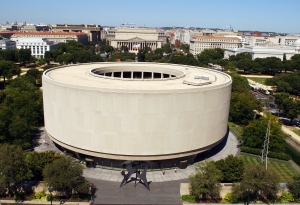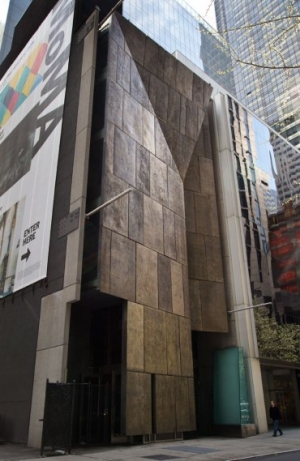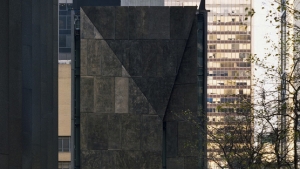|
Displaying items by tag: letter
A group of 54 artists and other art worlders has signed a letter asking Mayor de Blasio and Meenakshi Srinivasan, chair of the NYC Landmarks Preservation Commission, to deny the Frick Collection’s proposed plan for expansion.
“Those of us in the art world who cherish the unique and tranquil ambiance offered by the Frick are urging the Frick to withdraw its proposed plan and consider alternative methods of expansion that would preserve the character essential to its appeal,” says the missive, which is signed by gallerists Paul Kasmin and Irving Blum, filmmaker Sophia Coppola, and artists Jeff Koons, Chuck Close, John Currin, Brice Marden, Frank Stella, Cindy Sherman, Deborah Kass, Cecily Brown, Lisa Yuskavage, Rudolf Stingel, and Sarah Sze, among others.
Napoleon Bonaparte’s letter of surrender, in which he pleads for refuge in Britain, is to go on display to mark the bicentenary of the battle of Waterloo.
Addressed to the future George IV, the French emperor begs for the “hospitality of the British people” and calls on the prince regent as “the most powerful, the most constant, and the most generous of my enemies” for protection.
The letter is one of the centerpieces of an exhibition at Windsor Castle alongside a previously unseen letter from the Duke of Wellington, who defeated Napoleon at Waterloo.
She was married to Humphrey Bogart. Shot films with the likes of John Wayne and Paul Newman. And over her long career racked up a pair of Tony Awards and an honorary Oscar. But if there was one figure who made screen legend Lauren Bacall weak in the knees it was British sculptor Henry Moore.
Bacall, who passed away in August, was a longtime art collector, who amassed hundreds of artworks. Her tastes were broad and wide-ranging and her collection included African art and Pablo Picasso. But the actress had special affinity for works by Moore, whom she began collecting in the 1950s and first met in person in the mid-1970s.
A previously unseen letter written by Pablo Picasso, complete with sketches, has gone on display in western France.
The letter, to his friend the French poet Max Jacob, comes from a private collection and is displayed at the fine arts museum in the western city of Quimper.
Beginning "my dear Max" and signed "your brother Picasso", the letter shows the close bond between the Spanish artist and Jacob, who was "his best friend at the time and the person who really discovered him", according to museum director Ambroise Guillaume.

The Morgan Library & Museum in New York is currently presenting a selection of exceptional documents from the Gilder Lehrman Institute of American History, one of the country’s leading collections of Americana. Reflections on a Nation features documents from the Revolutionary, early national, antebellum, and Civil War periods that represent an array of transformative moments that took place throughout the history of the United States.
Highlights from the exhibition include the only surviving copy of a 1776 edition of the Declaration of Independence printed in the South, a first edition of Harriet Beecher Stowe’s Uncle Tom’s Cabin, a letter written by George Washington to secretary of war Henry Knox, and a letter written by Frederick Douglass to Mary Todd Lincoln. In it, Douglass thanked the president’s widow for giving him her husband’s walking stick, which he said was an indication of Lincoln’s “humane interest [in the] welfare of my whole race.”
Reflections on a Nation will be on view at the Morgan Library & Museum through January 12, 2014.
Graham Beal, the Director of the Detroit Institute of Arts, published a letter in the New York Times addressing the rampant rumors that have dogged the institution recently. Media outlets ran countless stories speculating about the museum’s future and that of its artworks after Detroit’s emergency manager Kevyn Orr asked for an appraisal of the D.I.A.’s collection.
In his letter, Beal specifically responded to an article published in the New York Times comparing the Detroit Institute of Arts to the shuttered Fresno Metropolitan Museum of Art and Science in California. Beal said, “True, any successful effort to liquidate D.I.A. art would precipitate a series of events likely to lead to its closing, but we are a very long way from actions that would denude its prestigious collection of its most valuable art works. We believe that a healthy D.I.A. is, in fact, a crucial component in any recovery of the city of Detroit.”
Beal’s letter can be read in its entirety at the New York Times.

The Croydon Council, a local authority in south London, will sell 24 antique Chinese ceramic vases, bowls and bottles to benefit the redevelopment of Fairfield Halls, a 50-year-old arts center in the area. Local businessman Raymond Riesco gifted the valuable objects to the Council in 1959 as part of a 230-piece collection of artifacts that included Ming dynasty bowls. The 206 objects retained by the Council will remain on view for the public.
The decision to break up the collection has drawn criticism from the museum sector. David Anderson, president of the Museum Association, told the BBC, “Croydon’s decision to sell valuable Chinese ceramics threatens not just its own reputation, but that of the museum sector as a whole. It would undermine the widespread public trust in museums and I strongly urge them to reconsider.”
Arts Council England has also voiced opposition to the sale and penned a letter to the Croydon Council earlier this month warning them that their decision was not in line with English museum standards.

Less than two months after Richard Koshalek, the director of the Hirshhorn Museum and Sculpture Park in Washington, D.C. resigned, Constance Caplan, the chair of the museum’s board, has followed suit. Caplan announced her resignation in a strongly worded letter on July 8, 2013; she is the third member to leave the board since early June. Caplan cited lack of transparency, trust, vision and good faith as her reasons for leaving. Koshelek listed similar reasons in his resignation letter.
Staff members have been losing faith in the Hirshhorn since it embarked on its doomed Seasonal Inflatable Structure project in 2009. The project was continually stalled due to rising construction costs and conflicting feelings about the structure’s purpose. It was ultimately abandoned after Koshalek’s resignation.
The original vision was to create a 150-foot-tall bubble that would connect the inside and outside of the Hirshhorn and create additional space for installations and performances. Designed by Diller Scofidio & Renfro, the bubble was expected to cost over $12.5 million to create and install. Previous fund-raising efforts brought in about $7.8 million. When it was first announced, the Bubble garnered national attention and was applauded for being highly innovated.

The nonprofit Architectural League of New York is the latest party asking the Museum of Modern Art to reconsider their decision to raze the former home of the American Folk Art Museum. The organization wrote an open letter signed by members of its board of directors to MoMA on Monday, April 22, 2013. Prominent architects such as Richard Meier, Thom Mayne, Steven Holl, Hugh Hardy, and Robert A.M. Stern voiced their support against the demolition of the building, which was designed by notable New York-based architects Tod Williams and Billie Tsien.
The monumental building, which features a sculptural bronze façade, was erected twelve years ago on West 53rd Street by the American Folk Art Museum. After the institution fell into financial turmoil, the building was sold to MoMA and the Folk Art Museum moved to a smaller location. Now, as plans for an expansion gain steam, MoMA has announced their decision to level the building. Officials justified the ruling by claiming that the Folk Art Museum’s former home didn’t mesh with MoMA’s sleek glass façade and that structure’s location was logistically problematic as it is slightly set back from MoMA’s main building.
The decision to demolish the structure, which has quickly become a Midtown landmark, has been met with a wall of opposition. Last week, a New Haven, CT resident, Robert Bundy, launched a petition against MoMA’s decision and garnered over 2,000 signatures in a matter of days.
As it stands, MoMA expects to begin renovations in 2014 by which time the Folk Art Museum’s former home will be destroyed.

After news spread that New York’s Museum of Modern Art planned to tear down the former home of the American Folk Art Museum on West 53rd Street in Manhattan, opponents launched a petition asking MoMA officials to reconsider the decision.
The petition was launched by New Haven, CT resident, Robert Bundy, and has accrued over 2,000 signatures. In a letter written to MoMA’s director, Glenn D. Lowry, and the museum’s chief architecture curator, Barry Bergdoll, Bundy asks that MoMA preserve the building rather than raze it, which he claims would be an architectural loss for the city of New York.
The building in debate was designed by notable New York-based architects Tod Williams and Billie Tsien to house the Folk Art Museum. The project was completed in 2001 but after falling into financial turmoil, the Folk Art Museum decided to sell the building to MoMA and move to a smaller location.
The decision to level the structure, which features a sculptural bronze façade, is part of MoMA’s overarching expansion plans. Officials claim that the former Folk Art Museum building doesn’t mesh well with MoMA’s neighboring sleek, glass façade. The Folk Art building is also set back slightly from MoMA making expansion logistics more complicated.
In Bundy’s letter he writes, “We ask that the Museum of Modern Art reconsider its position and save the former American Folk Art Museum. The destruction of the building will result in MoMA no longer being regarded as a protector and promoter of the arts.” The petition can be found on change.org’s website.
|
|
|
|
|